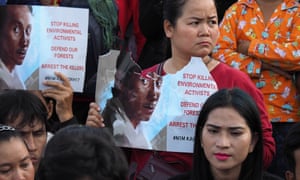The number of people killed this year while defending their
community’s land, natural resources or wildlife has passed 150 – meaning
2017 is on course to be the deadliest year on record.
Environmental activists, wildlife rangers and indigenous leaders are locked in fierce conflicts with mining, logging and agricultural companies in hundreds of places around the world. The Guardian is working with watchdog Global Witness to record all the deaths in 2017, and this week that figure reached 153 with a spate of killings across three continents.
These included Ruben Arzaga, a village leader and environmental officer shot while arresting suspected illegal loggers in the Philippines; Elías Gamonal Mozombite, one of six farmers shot dead in a land rights battle reportedly linked to palm oil trade in Peru, and Wayne Lotter, a leading elephant conservationist and head of an anti-poaching NGO shot dead in Tanzania.
Billy Kyte of Global Witness said the latest deaths underlined the scale of the crisis facing those seeking to protect their land and environment from global corporations and governments.
“These stark statistics show 2017 looks like being the deadliest yet for those on the frontline to protect our environment and their land rights.”
Kyte said Brazil, Colombia and the Philippines were set to be the most dangerous places – as they were in 2016.
“The heads of these governments must recognise this crisis and prioritise the protection of these defenders. Without guaranteeing communities a say in how their land and natural resources are used, the roots of this violence will continue to grow.”
The findings show that mining and extractive industries continue to be the industry linked to the most killings – 33 so far this year.
There has also been a surge in deaths associated with agribusiness – 28 deaths so far this year, compared with 23 for the whole of 2016. And more park rangers have been killed already in 2017 than during the whole of last year.
Kyte said some progress appeared to have been made in Honduras, historically the world’s most dangerous place per capita, where deaths dropped from 14 in 2016 to only one this year so far.
However, he added: “Whilst this is welcome, news there continues to contain regular reports of threats, harassment and criminalisation of activists and human rights defenders in the country.”
Last year 200 environmental activists, wildlife rangers and indigenous leaders were killed. And with that figure set to be exceeded, Kyte warned that investors as well as governments and global corporations had a key role to play.
“Investors too have blood on their hands. They should not invest in projects linked to abuses and must speak out when defenders are threatened.”
Environmental activists, wildlife rangers and indigenous leaders are locked in fierce conflicts with mining, logging and agricultural companies in hundreds of places around the world. The Guardian is working with watchdog Global Witness to record all the deaths in 2017, and this week that figure reached 153 with a spate of killings across three continents.
These included Ruben Arzaga, a village leader and environmental officer shot while arresting suspected illegal loggers in the Philippines; Elías Gamonal Mozombite, one of six farmers shot dead in a land rights battle reportedly linked to palm oil trade in Peru, and Wayne Lotter, a leading elephant conservationist and head of an anti-poaching NGO shot dead in Tanzania.
Billy Kyte of Global Witness said the latest deaths underlined the scale of the crisis facing those seeking to protect their land and environment from global corporations and governments.
“These stark statistics show 2017 looks like being the deadliest yet for those on the frontline to protect our environment and their land rights.”
“The heads of these governments must recognise this crisis and prioritise the protection of these defenders. Without guaranteeing communities a say in how their land and natural resources are used, the roots of this violence will continue to grow.”
The findings show that mining and extractive industries continue to be the industry linked to the most killings – 33 so far this year.
There has also been a surge in deaths associated with agribusiness – 28 deaths so far this year, compared with 23 for the whole of 2016. And more park rangers have been killed already in 2017 than during the whole of last year.
Kyte said some progress appeared to have been made in Honduras, historically the world’s most dangerous place per capita, where deaths dropped from 14 in 2016 to only one this year so far.
However, he added: “Whilst this is welcome, news there continues to contain regular reports of threats, harassment and criminalisation of activists and human rights defenders in the country.”
Last year 200 environmental activists, wildlife rangers and indigenous leaders were killed. And with that figure set to be exceeded, Kyte warned that investors as well as governments and global corporations had a key role to play.
“Investors too have blood on their hands. They should not invest in projects linked to abuses and must speak out when defenders are threatened.”

No comments:
Post a Comment